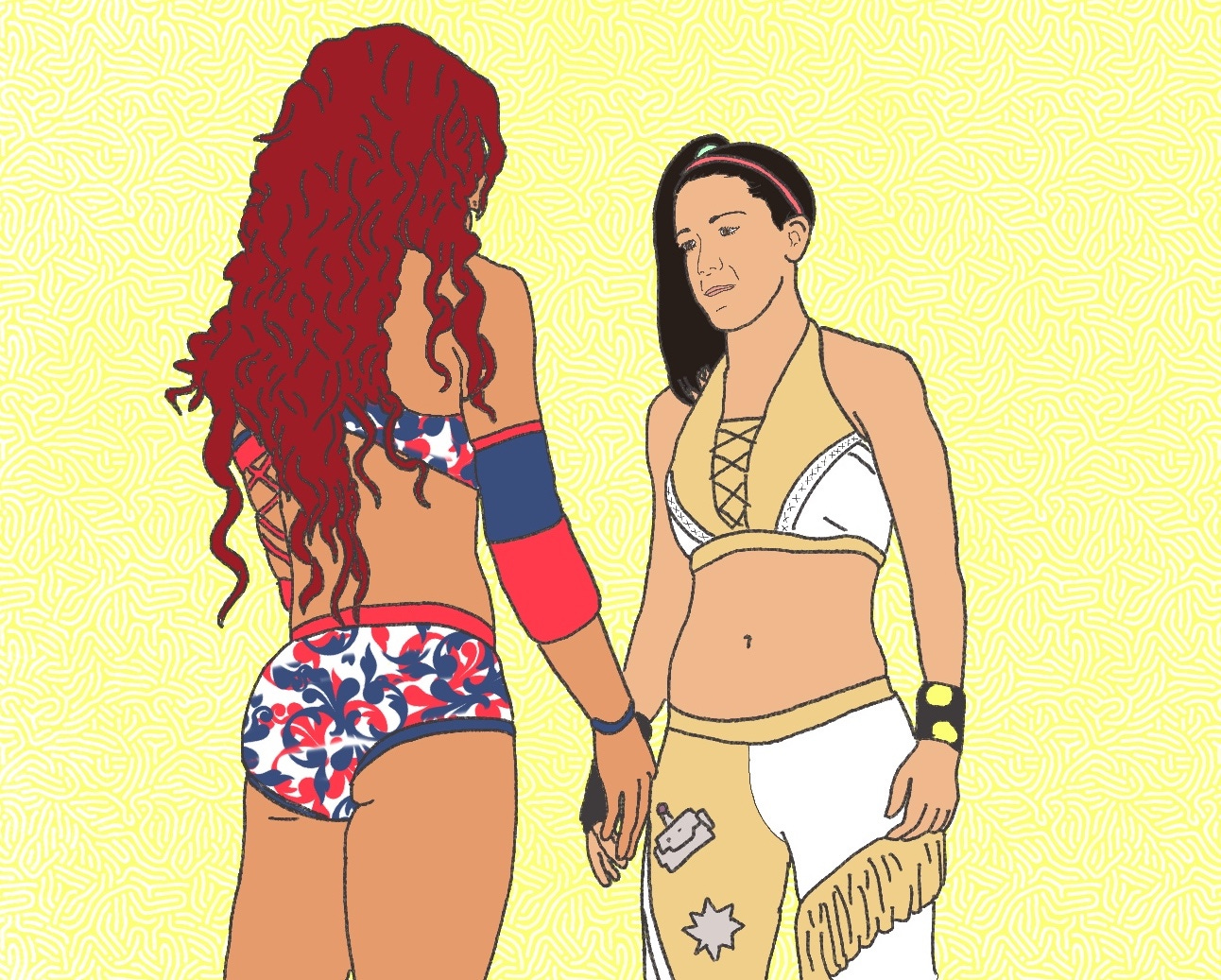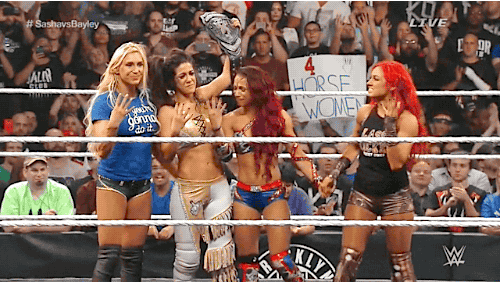
It’s not easy to pick a favorite wrestling match. I’d guess it would be hard for you too on account of you almost certainly not being a fan. It’s hard for me because I’ve watched so many matches over the years that I’ve enjoyed in so many different ways for so many different reasons. I have been lucky enough to attend a pretty incredible run of shows the last few years in particular, so even picking the best one I’ve witnessed live would require a lot of thinking. But my favorite among those, the one most lodged into my heart? That’s easy. It’s Sasha Banks vs. Bayley, in Brooklyn in 2015. I imagine it always will be.
First, some context. Since the 1990s, WWE (née the WWF) has had an internal feeder system — a minor league of sorts — where new wrestlers could learn or hone their craft on a smaller scale, typically a regional promotion in the South or Midwest, before they debut on WWE TV proper. In 2012, they spruced it up under the moniker NXT (which, no, does not stand for anything) and began taping it at a dedicated studio in Orlando in front of a few hundred people. It aired online; without the demands of primetime TV and corporate micromanagement, characters and stories had more room to develop organically. The whole thing had an endearing sort of plucky upstart feel (at least as much as possible for what was still the product of a billion-dollar company) as its niche but dedicated audience watched performers grow on the job. The cult following quickly grew too, enough so that in 2015 WWE gave NXT its first major-arena show, NXT Takeover: Brooklyn, at the Barclays Center — a 10-minute walk from my apartment. I wasn’t going to miss it for the world.
For me, the marquee match was the one for NXT’s women’s championship, with the champion Sasha Banks defending against Bayley. The two had shown up around the same time a couple years before, both beginning on NXT as fresh-faced newbies who languished in the women’s divisions lower levels. (Also, to be clear, I am writing henceforth about the characters of Sasha Banks and Bayley, i.e. their fictional personas, not the real-life women portraying them.) From there their paths diverged: Bayley stayed the most pure-hearted of fan favorites, while Banks became a ruthless megalomaniac who dubbed herself “the Boss.” They repeatedly crossed paths on their slow rises up the ranks, intermittently feuding but always standing as the two poles on the division’s spectrum of good and evil. Twice Bayley was abandoned by her closest friend — first Charlotte Flair, then Becky Lynch — so that they could align with Banks and, like Banks, use cruel tactics to achieve a level of success that had eluded their more virtuous contemporary. Those four became known as NXT’s Four Horsewomen (a play on the legendary stable headed by Flair’s father), a group whose standout performances and popularity helped belatedly transform how WWE presented its female talent. (To give an idea of the internal backwardness the company’s women were up against, WWE promoted this period as the “Divas Revolution,” in keeping with its gendered branding.)
In the summer of 2015, Flair, Lynch, and Banks (by then NXT’s women’s champion) were all “called up” to also wrestle on WWE’s main programming, Raw and Smackdown, while Bayley — as always, lagging behind the others — worked her way back from a broken hand in lowly NXT. That’s where we arrive at the build to the show in Brooklyn, as captured in this pitch-perfect three-minute hype video that I have watched too many times to count:
Banks was and remains one of my personal favorite performers, but in Brooklyn I wanted wholeheartedly to see her lose. At the time I was five years into my time at SI, still primarily a fact-checker while writing here and there and struggling to break through to bigger things at my dream employer. Bayley’s story resonated. The basis of her character was that she was a WWE superfan who was so happy to be there that she could hardly believe it and whose talent was often undermined by shaky confidence. There might have been more aggressive ways to get ahead, but she stayed the course and just tried to work hard and be nice to everybody. If she kept it up and stayed patient, maybe, eventually, her time would come. Or maybe, like her trick-mirror nemesis kept telling her, she just didn’t really have what it took to be great.
Wrestling is best understood as a mixture of theater and sport, and one thing it has in common with both is that watching it in person can enhance your enjoyment exponentially. The immersion of the experience — the immediacy of the theatrics, the roaring crowd — has a multiplying effect on your investment and, crucially, catalyzes the suspension of disbelief. (Imagine being able to somehow attend the season finale of your favorite TV show, as you would a play.) There were more than 15,000 people at the Barclays Center that night, and though the show’s closing bout would be a well-anticipated match for NXT’s men’s championship, it seems fair to say that most were more eager for the women’s match preceding it. There is nothing better and more satisfying in wrestling than a hero’s slow climb to the top. (See: Daniel Bryan’s Yes Movement.) Bayley had to win, right? But wrestling — especially WWE-produced wrestling — is a never-ending story, always laced with the threat that this supposedly climactic match will instead be used to set up yet another supposed climax. (Yes, this is generally very frustrating.) But more importantly, even if Bayley’s victory seemed as logically inevitable as a movie superhero’s, we hadn’t seen it yet. We hadn’t experienced it. We hadn’t felt it. And in the story of Bayley and Sasha Banks, feelings were the entire point.
Don’t worry. I’m not going to bother recapping the match. You really should just watch it (or even the highlights), though I know my subscriber list too well to think you will. But (spoiler alert!) know that in the ring that night they delivered a consummate story of two foes who know each other in and out, of a champion whose strategy is to be as cutthroat as needed and of a challenger who reaches within to finally find a version of herself big enough for her biggest moment. There are plenty of matches I can recall watching live with clarity, but almost never are memories of specific sequences — Banks somersaulting herself over the referee and out of the ring, her merciless stomps on Bayley’s injured hand, Bayley’s defiant ponytail adjustment in the match’s closing moments — so vivid that I can still feel them. It provided the most elusive thing in modern WWE: a fully satisfying narrative conclusion. Documentary cameras caught then-WWE champion Seth Rollins, who was seated in the front row, wiping away a tear in its aftermath. He wasn’t alone.
The night’s lasting image came after the match. Flair and Lynch, Bayley’s former ex-friends who had by now turned good again (wrestling!), rushed to the ring and lifted her for a watery-eyed victory lap. Eventually Banks rose and embraced Bayley too, sharing a long and tearful hug to a swell of cheers. The Four Horsewomen shared a curtain call that was beautiful in its fourth-wall-breaking realness, a sort of graduation ceremony for a group of real-life friends who we had watched become stars together. But it felt like it worked on a character level too — like in the end, after all the others’ betrayals and antagonism, it was Bayley who had spiritually won out and pulled them over to her side. She was finally good enough, for everybody.

Of course, the story did not really end there. This is still wrestling. Two months later there was a (very good) rematch that served as the main event of another major show, a first for women in WWE. The narrative became that Bayley earned Sasha’s respect (thus signaling the end of Sasha’s villainy) just as Banks moved on from NXT for good. The next summer Bayley debuted on the main roster as Sasha’s mystery tag-team partner in a great moment made even greater by Banks’ uncontainable joy at the crowd’s reaction to the reveal. Their partnership has survived seemingly endless breakup teases in the years since, a significant unlikelihood in wrestling.
But things have still changed. WWE’s main roster writers could never quite rekindle what made Bayley such a special and pure act on NXT. Last year Sasha turned heel again. This time Bayley made a different choice. She followed suit. She’s a different Bayley, but she is the champion. Now she and Banks are, for a second time, champions as a team too.
That’s life. And that’s especially wrestling. You need to keep evolving, to find and grow new parts of yourself, so you don’t get stuck treading water. It’s been fun seeing Bayley (as a performer) do that too and find success in new ways. None of it will change that one immaculate night when just being Bayley — the best Bayley — was more than enough.



